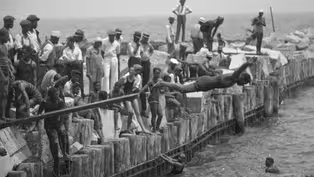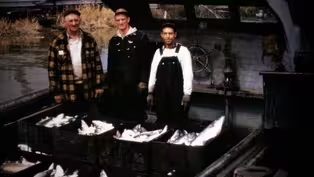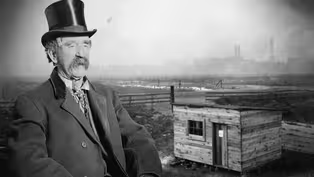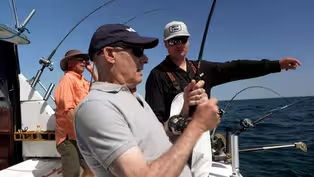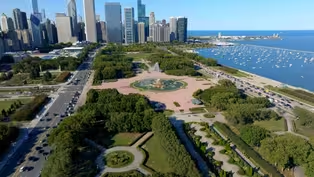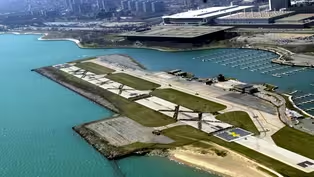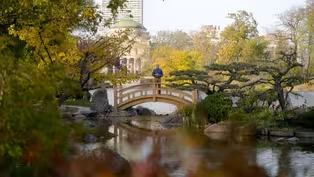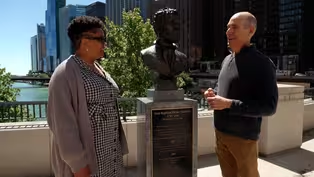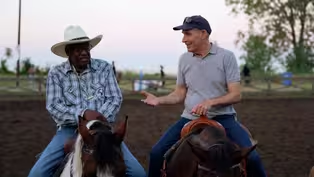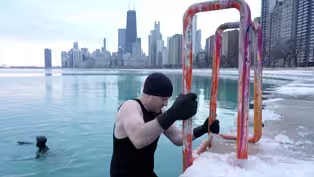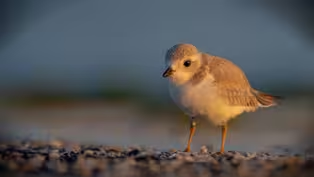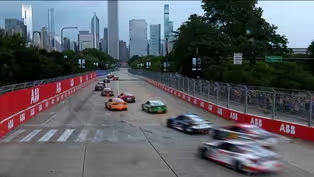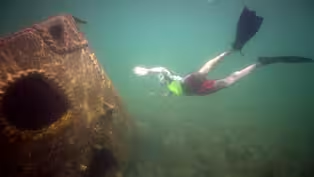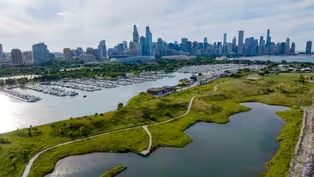
Touring Chicago's Lakefront
Special | 55m 53sVideo has Audio Description, Closed Captions
This is the story of how the lakefront was envisioned, built, and defended.
After its people, Chicago’s lakefront is its greatest asset. But don’t take the lakefront for granted — it was by no means inevitable that Chicago’s crown jewel would end up so dazzling. This is the story of how the lakefront was envisioned, built, and defended. And how the struggle continues, under pressure from development and climate change.
See all videos with Audio DescriptionADProblems playing video? | Closed Captioning Feedback
Problems playing video? | Closed Captioning Feedback
Chicago Tours with Geoffrey Baer is a local public television program presented by WTTW

Touring Chicago's Lakefront
Special | 55m 53sVideo has Audio Description, Closed Captions
After its people, Chicago’s lakefront is its greatest asset. But don’t take the lakefront for granted — it was by no means inevitable that Chicago’s crown jewel would end up so dazzling. This is the story of how the lakefront was envisioned, built, and defended. And how the struggle continues, under pressure from development and climate change.
See all videos with Audio DescriptionADProblems playing video? | Closed Captioning Feedback
How to Watch Chicago Tours with Geoffrey Baer
Chicago Tours with Geoffrey Baer is available to stream on pbs.org and the free PBS App, available on iPhone, Apple TV, Android TV, Android smartphones, Amazon Fire TV, Amazon Fire Tablet, Roku, Samsung Smart TV, and Vizio.
Whether you're flying home or just visiting, Chicago gives air travelers a spectacular welcome, and it's all because of our one-of-a-kind lakefront.
(camera clicks) This is the story of how the lakefront was envisioned, Built, and defended.
How rare is it that the waterfront is reserved for the public?
And how the struggle continues, with the lakefront under pressure from shoreline erosion, invasive species, and just too much of a good thing.
(engines rumbling) People believe it should be for the people.
From the skies to the seas, from enlightenment to adventure.
Whoa, man!
There you go.
(crowd cheers) [Geoffrey] Some stories will be familiar.
I call him my historical boyfriend.
Others brand-new.
Oh, I see him!
I got him!
Oh, there he is.
We'll dive into the lakefront's unique blend of big city and natural beauty.
It never gets old.
But those are my mountains.
Those are my mountains.
I'm Geoffrey Baer.
Join me for stories from the Chicago lakefront.
(light music) Lead support for Touring Chicago's Lakefront with Geoffrey Baer is provided by: Lead corporate support is provided by: Major support is provided by: Additional support is provided by these donors: Boy, it doesn't get much better than this, does it?
Sailing off the coast of Chicago, Taking in that beautiful skyline view.
Now somewhere hidden in that spectacular skyline is the place where you could argue modern-day Chicago began: the mouth of the Chicago River.
It takes some imagination to go back in time in your mind, clear away the skyscrapers and bridges and piers.
And you can see why Chicago's early settlers picked that spot where the river meets the lake.
(light music) One person who saw the potential arrived in the 1780s.
The man many considered the founder of modern-day Chicago: Jean Baptiste Point Du Sable.
One of the things that has survived him is That he was a well-educated and handsome Negro with an affinity for drink.
And to me that's like a swipe right on a dating profile, If you were to ask me that.
(Geoffrey laughing) [Geoffrey Voiceover] Lake Forest College professor Courtney Pierre Joseph is a historian and Du Sable expert.
I just have come to love him the more and more That I've learned about him.
This bronze bust in the shadow of Tribune Tower On Michigan Avenue marks the spot Where Du Sable built his homestead.
So we've got the Apple store and you know, the Wrigley building and Tribune Tower and Michigan Avenue.
What would this place have looked like in 1790, when he settled here?
Definitely not as fancy.
The fact that his homestead is on the mouth of the Chicago River Where it meets Lake Michigan speaks of the importance of water to his story and water to the understanding why Chicago is such an important hub.
Du Sable got around thanks to water.
Professor Joseph says he was a half-French, half-Black man from Haiti who sailed from the Caribbean and traveled up the Mississippi, Illinois, Des Plaines and Chicago Rivers.
He built good relations with the local tribes who'd lived here for thousands of years, in partnership with his wife, Kitihawa, a Potawatomi woman.
And here on the lakefront, they built a home That was much more than the modest cabin earlier historians described.
And it was quite a house, wasn't it?
That was a big house.
It has these French-inspired doors.
There's art inside the home.
Yeah, I've heard one detail that there were glass doors.
Yeah.
To have glass doors- I mean killing the game, really, As I always like to think about him.
Du Sable's success as a businessman and trader is documented in this bill of sale, transferring his settlement to a man named Lalime in 1800.
He'd built the 1790s equivalent of a big box store with a bakehouse, dairy, smokehouse, and poultry house.
He had a barn, 30 head of cattle, 38 hogs, and 44 hens.
And so if we imagine his home and all of these things coming up to the water Where he's able to greet people, where he's able to trade with people have these diplomatic meetings and such, the water is really important to understanding How people came and went.
But if Du Sable built his home right on the lake, why is the site of his homestead a half mile from shore today?
Well, it's because this part of Chicago used to be under the surface of Lake Michigan.
Millennium Park?
Well, the Bean would've been a boat if it existed in the 1840s, because Michigan Avenue was lakefront property.
Even back then it was some of the ritziest real estate in Chicago.
It was called Terrace Row.
Now, in the summer, Terrace Row residents luxuriated in their cool lakefront breezes.
But come November, and angry winded waves threatened to wash it all away.
An estimated 20 acres of lakefront had vanished due to powerful waves and erosion.
The fledgling city desperately needed a breakwater to protect Terrace Row residents from Lake Michigan's wrath.
But who would pay for it?
The city saw an angle.
It allowed the Illinois Central Railroad to run its tracks right up the lakefront on a trestle about 100 yards offshore.
And in exchange, the railroad built a sea wall to protect the shoreline.
This early example of The Chicago Way left Terrace Row residents conflicted.
On the one hand, they didn't want their million dollar views Spoiled by steam trains belching coal dust, but they didn't want their mansions floating away into the lake either.
Ultimately, the lakefront got railroaded.
(train horn blaring) Fast forward to the 1890s, the lake has been filled in between the shore and the tracks in part with ashes from the Great Chicago Fire creating a makeshift lakefront park.
And Terrace Row townhomes have been replaced By commercial buildings.
One of them is home to a booming mail order business founded by A. Montgomery Ward.
Ward had his offices and warehouse in this building right on Michigan Avenue.
He said he wanted his employees to have the light and fresh air of the lakefront.
But when he looked out his office window, what he saw made his blood boil.
He was appalled by garbage dumps, circuses, and shanty towns that littered what was then called Lake Park.
But Ward's lawyer found salvation in five words written on an old map.
In 1836, the canal commissioners who platted the city had declared that this part of the lakefront Should remain, quote, "forever open, clear, and free of any buildings or other obstructions whatever."
For the next 20 years.
In lawsuit after lawsuit, Ward used those five words as a cudgel to clear away the clutter and beat back anyone who wanted to build on this part of the lakefront.
He said he did it for the poor people of Chicago, not the millionaires, but his legal victories cost him time, money, and friends.
Near the end of his life, Ward told the Chicago Tribune, "Had I known in 1890 how long it would take me to preserve a park for the people against their will, I doubt if I would have undertaken it."
(light playful music) Chicago's most famous lions aren't in the zoo.
They've been guarding the entrance To the Art Institute since 1894.
And have you ever noticed, they're not twins.
Artist Edward Kemeys said his northern lion is "on the prowl" and he gave the southern lion a look of "defiance" with eyes in the distance.
Now, if these guys could talk, maybe they could explain how the Art Institute escaped Montgomery Ward's lawsuits and ended up being built right in Lake Park.
The short answer is the museum got the consent Of its neighbors.
But it probably didn't hurt that Montgomery Ward was on the Art Institute's board of trustees.
When he died, the museum said the, quote, "watchdog of the Lake Front was always a friend to the Art Institute."
Right, guys?
(lions roar) Lake Park was renamed Grant Park in 1901 to honor the Civil War General and US President.
And by now, it had grown from a narrow strip along the lakefront to 319 acres.
In 1927, Chicago turned on Buckingham Fountain inspired by the Latona Fountain of Versailles in France.
But Chicago's Rococo masterpiece is twice as big as Louis XIV's.
In fact, it's one of the biggest fountains in the world.
Buckingham Fountain sealed Grant Park's reputation as Chicago's front yard.
(bright music) (fountain shimmering) During the Democratic National Convention of 1968, that front yard ended up on front pages all across the country.
An estimated 10,000 protestors rallied in Grant Park united in opposition to the Vietnam War, much to the dismay of Chicago's powerful mayor, Richard J. Daley.
The intention of these terrorists was openly displayed.
They came to Chicago to disrupt the national political convention and to paralyze our city.
[Geoffrey] Their planned protest march Barely made it out of Grant Park before police moved in.
(crowd yells) (tense music) The whole world was watching, and Grant Park became emblematic of 1960s' turbulence.
But 40 years later, fear and loathing in Grant Park was replaced with hope and change.
[Crowd] Obama!
Obama!
(crowd cheers) [Geoffrey] On November 4th, 2008, 200,000 people were there when the TV networks called it- (crowd cheers) And Chicago made history welcoming America's first African American president, Barack Obama.
(crowd cheers) [Crowd] Yes, we can!
(tense rock music) Year after year, Grant Park's pastoral purpose has been eclipsed by mega events leading some to say, "our front yard is overbooked," especially in summer.
There's Lollapalooza, Blues Fest, Taste of Chicago and the thunderous sound of NASCAR.
(engines rumbling) Just another quiet evening on the lakefront.
When the NASCAR Chicago Street race was announced, There was initial resistance, even anger.
People worried about traffic and the impact on the park.
Mayor Lori Lightfoot had to play defense.
Why was it important to bring NASCAR to your city?
I think it's gonna be one of the most iconic race courses maybe ever.
[Geoffrey Voiceover] And after the second year of NASCAR, The jury was still out.
But to those who think race cars don't belong on the waterfront, there is historical precedent.
(upbeat retro music) America's very first auto race started a few miles down the lakefront in Jackson Park on Thanksgiving Day, 1895.
Only six cars competed, four were gasoline powered, and two were electric.
Only two cars finished due to a surprise snowstorm and mechanical problems.
The winner completed the 50-mile course To Evanston and back in just over 10 hours with an average speed of about 5 miles an hour.
At the Chicago Street race, NASCAR drivers hit top speeds of well over 100 miles per hour.
You want to take a picture of all of you guys?
Daniel Suarez is one of NASCAR's top drivers.
So when you're out there racing, like do you do any sightseeing?
Like, "Oh look, it's Buckingham Fountain?"
Oh no, no, no, no.
For me the fountain is corner number 8 and 9.
I don't see them.
[Geoffrey] I don't look for the fountain.
Oh no, no, no, no.
That's corner 8 and 9 this weekend.
Here we are, how about it?
There's the guy right here.
Come on right in here.
Where are you from?
I'm from Elgin.
So I'm from Houston.
My son lives in Chicago.
Have you ever been to a car race before?
Yesterday I went as well because I got tickets from school.
Have you ever been to a NASCAR race?
This is my first NASCAR race.
Really!
Well, whaddya think about having a race In the middle of a park?
It's pretty cool, once in a lifetime thing, Lake Shore Drive!
You're going to be driving on these streets next week.
And you're going to be thinking, man!
Daniel was running 170 miles right here.
(laughs) That is 100% what I thought last year.
I could see, like, tire marks and things and I'm like, "they were just here racing right on this street!"
And that's going to happen to you And a million other people.
So that's why I think that street racing is amazing.
Just a short walk south from the frequent hustle and bustle of Grant Park, past popular attractions like the Field Museum, Shedd Aquarium, and Adler Planetarium is a lakefront gem where you can still truly get away from it all: Northerly Island.
Chicago has a lot of surprises, but I think this might be the biggest surprise in Chicago.
Now, the domain of birds and bees, The sky above Northerly Island was once filled with a different kind of air traffic.
(aircraft humming) We would literally be like flying in for a landing right now.
Stewart Hicks is an architecture professor.
And there were a lot of people that did it, too.
It was a very, very busy airport.
[Geoffrey Voiceover] From 1948 to 2003, Meigs Field was a rare bird, an airport for small planes right downtown and smack dab on the lakefront.
Meigs was even the default airport for Microsoft's flight simulator.
[Simulator Narrator] Be careful, You're getting a little low.
[Geoffrey Voiceover] Introducing millions of people Throughout the world to Chicago's skyline.
[Simulator Narrator] Wait a minute to extend the flaps.
[Geoffrey Voiceover] Despite Meigs' iconic status, Mayor Richard M. Daley thought the island, which is really a peninsula, would better serve the public as a park.
Entanglements with the state blocked the mayor's plans.
But after the 9/11 attacks, Daley claimed an airport so close to downtown was a security threat.
In the middle of the night on March 31st, 2003, he launched a brigade of bulldozers and trackhoes.
Well, we took appropriate steps to do it- [Reporter] Why?
Why do it in the middle of the night?
We made the decision and we did it for public safety.
[Geoffrey Voiceover] Daley didn't tell City Hall, Springfield, or the Federal Aviation Administration.
It was just his word signed with an X.
Some planes were stranded here, some couldn't get away.
But after that, this was no longer an airport.
Strangely enough, Daley's strongman stunt brought Northerly Island closer to its original progressive idea, conceived by legendary urban planner, Daniel H. Burnham, he of "no little plans."
The lakefront was the crown jewel in Burnham's 1909 "Plan of Chicago."
He called for a string of manmade islands to protect the lakefront and create green space.
This was the only one ever built.
We would've seen a chain of islands down the shore, right?
That's right.
So yeah, we've got the northern part of something That was meant to be much larger and would've framed a lagoon that would've also created a certain kind of framed nature or framed water that would've been accessible to people of Chicago.
Who knows, maybe Daley had Burnham in mind When he ordered those bulldozers, Because Burnham wrote "The Lake front by right belongs to the people."
And that statement fills the minds of people's imagination.
People believe it should be for the people.
And so when they see a tower right on the water, people get a little maybe upset that it doesn't quite follow that vision.
[Geoffrey Voiceover] Not many people use this park, Which is still a work in progress Decades after the demise of Meigs Field.
But it's worth a visit.
The lush landscape is bursting with wildflowers and native plants.
But what Burnham approved, on the one hand, he cherished open space and quiet as an antidote to the crowds and filth of late 19th century Chicago.
But Burnham couldn't help trying to improve upon nature, as though it would be even better with orderly design and classical symmetry.
Nature was a little too untidy for Burnham.
(laughing) I think so.
Or the way we would think about it today, for sure.
You might say Northerly Island is an updated Burnham, Burnham in Birkenstocks.
He might look at this today and just say, "What?
Who let this all go to weed?
Why is it all covered with weeds?
But they're wildflowers, they're native plants.
Exactly, and other people today might come and think how beautiful it is that we've been able to accept these kinds of plantings and animals and things that would've been here otherwise, Right next to and part of the City of Chicago.
(light music) (birds chirping) The beach at 31st Street is lovely, but behind the beauty is a dark history.
I am still just struck by looking behind us, How beautiful it is.
What a beautiful scene that turns incredibly tragic.
[Geoffrey Voiceover] Historian Courtney Joseph and I Gaze across the water and across time to a spot where racial violence exploded in the red summer of 1919.
What I wanna start with is Eugene Williams.
Yeah.
I mean, you know much like Emmett Till, He's the kid who got murdered.
Yeah, unfortunately.
But what was he like?
Do we know what Eugene Williams was like?
We do.
We know a little bit about him.
His parents migrated to Chicago anywhere from 1906 to 1909.
(light music) [Geoffrey] It was the beginning of the first wave Of the Great Migration.
Approximately 2 million African Americans fled the rural South for industrial cities in the North.
Because of racist housing policies in Chicago, most migrants were restricted to living in a narrow strip along South State Street, today known as Bronzeville.
The places now that you can kind of do Like Black history tours and stuff, kind of not too far away from where we are right now.
[Geoffrey] It was hot on July 27th, 1919 when Eugene Williams and several friends headed to the beach and jumped into the lake holding onto a homemade raft.
Chicago in 1919 was officially integrated, but many of its parks were defacto segregated.
A 24-year-old white man named George Stauber apparently believed the boys drifted Across an invisible color line.
Witnesses later said Stauber was standing on a pier when he began throwing rocks.
When one hits Eugene in the side of his head and he begins to drown and his friends, who also cannot swim that well, cannot save him.
And they're also being attacked with these rocks.
And they swim away.
And by the time anyone can go, he has already passed away.
[Geoffrey] A group of African American beachgoers Approached a white police officer on the beach and demanded that the rock thrower be arrested.
And not only did the police not want to make the arrest, But stood in when a Black officer tried to step in to arrest the man, stopped him from doing it.
And an African American shoots a gun into the air and the police then shoot into the crowd.
And from there, the riot begins.
[Geoffrey] The melee spilled over Into surrounding neighborhoods.
White mobs targeted Black homes in Bronzeville in particular.
[Courtney] So arson and beatings and looting of property and all sorts of things happen that the police themselves can't quell and in many ways don't try to.
[Geoffrey] It was the worst possible homecoming For some Black residents of Chicago who expected a hero's welcome after fighting for the US in the First World War.
One of the most infamous photos is a soldier dressed in his uniform standing toe to toe with a white Chicagoan.
They're looking at each other in the eye And there's this defiance in the photograph of like, "You know, I'm a US soldier.
How could that not be more American?"
And instead it's this, you know, need to kind of put them back in their place As second-class citizens that I think is part of the powder keg that pops on that July day.
(dramatic tense music) (somber music) The riot raged for a week, before Governor Frank Lowden called up the National Guard, and order was finally restored.
Thousands were injured in the riot, Which left 38 people dead, 23 Blacks and 15 whites.
George Stauber, the alleged rock-thrower Was charged with manslaughter, but was acquitted.
It took 90 years for the city to recognize the tragedy with a granite marker along the lake.
The plaque quotes Dr. Martin Luther King: "Darkness cannot drive out darkness.
Only light can do that."
(bright music) (waves murmuring) (engine humming) South of 31st Street Beach, a dive boat takes us to one of the lakefronts most surprising secrets.
Going to a shipwreck.
A shipwreck that's just 600 feet from Lakeshore Drive in the Kenwood neighborhood.
And you don't have to be a scuba diver to see it.
It's just inches below the surface on an ancient rocky reef called Morgan Shoal.
(water splashes) (soft music) As you're swimming up to it, it just kind of appears out of the gloom.
[Philip] Yeah, it is kinda like a sea monster Coming out to get you a little bit.
[Geoffrey] This is the boiler of the doomed steamship Silver Spray.
It's been here since July 15th, 1914.
On that fateful day, Silver Spray was headed to the University of Chicago to pick up business students and take them on a field trip to a Gary, Indiana steel mill.
So the steamer set out from Chicago, headed down here, clear skies, perfect weather, and ran smack into Morgan Shoal.
Right out here actually.
[Geoffrey] Fortunately for the students, They hadn't boarded yet.
It was just the crew run aground on Morgan Shoal.
At first, they were more interested in eating lunch than abandoning ship.
But after three days, the wind picked up and the crew jumped overboard as waves smashed the wooden hull against the rock.
[Philip] Bits and pieces of the Silver Spray Then washed up on shore.
Because it was so close, hundreds of people were watching this, and they started picking up pieces of this driftwood And starting fires.
Not just fires but bonfires.
[Geoffrey] The Chicago Examiner wrote, "Like a Roman holiday, bonfires of the sturdy timbers were built and in their flaring light a feast of the remnants was made."
Parties broke out, it started to get outta hand.
And finally the Chicago Police had to come through And clean the place out before it got completely outta control.
(both chuckling) [Geoffrey] The crew swam ashore and all survived.
All that remains is the ship's boiler and propeller.
Totally blew my mind to see it.
And all the old-fashioned like rivets around it.
(gentle music) I was curious about the rock that sank the ship, because most of Lake Michigan's bottom Is nothing more than sand and muddy sediment.
Turns out this rock has a story too.
It was once a coral reef.
If we go back in time, 425 million years- Oh, just a few years.
Few years.
Chicago was actually south of the equator and it was in a shallow, tropical sea, underwater.
We would've had a good tourist trade 400 million years ago.
It would've been totally different- It would've been just visit tropical Chicago.
It would've been just like the Caribbean.
[Geoffrey] But continental Drift crashed the beach party and moved tropical Chicago to the 42nd parallel.
Over millions of years, the reef died and transformed into a kind of rock akin to limestone called dolomite.
Today this massive dolomite shelf stretches all the way to Buffalo, New York where Niagara Falls spills over it.
Morgan Shoal is one of the rare spots in our area Where the dolomite pops up above the lake floor or topsoil.
It's mostly buried hundreds of feet below ground where it serves an important modern day purpose.
It's quarried for gravel and concrete and it supports our skyline.
[Philip] This bedrock extends throughout the region And some of the skyscrapers in downtown Chicago have some of their pilings driven down into this bedrock.
If I put my hand right on the rocks down there- That rock is 425 million years old.
Predates the dinosaurs by hundreds of millions of years.
Glaciers came and went.
It's Lake Michigan now.
I mean, it's seen so much history.
[Geoffrey] And I could put my hand right on it.
Touch Morgan Shoal and you touch the foundation of Chicago.
(light music) Due south from Morgan Shoal is Promontory Point.
This 40-acre park on a peninsula is a respite from big city stress and a beloved place for couples to take the plunge.
And your love is a mutual love.
Often people literally take the plunge, as swimmers flock here year round.
Originally conceived by Daniel Burnham in his 1909 plan, Promontory Point took more than 15 years to build at the height of the Great Depression.
In 1953, the Cold War gave the Point a new purpose that Daniel Burnham couldn't have imagined.
It bristled with radar towers as the control center for a nearby Nike missile base, the last line of defense against Soviet attack.
Neighbors protested the peninsula's militarization For years, but the towers remained, until the Nike system was decommissioned nationwide in the 1970s.
Today, whether they know it or not, South siders are fulfilling the promise Of the parks designer, "Prairie School" landscape architect Alfred Caldwell.
He wanted to capture the meeting of the Great Lakes And the prairie with sea walls and council rings in his signature limestone.
Ponder that, or just enjoy your hot dog.
(light music) Just south of Promontory Point, Jackson Park is the grand dame of the South Lakefront.
It was designed in 1869 by the creators of New York's Central Park, Frederick Law Olmsted and Calvert Vaux.
Olmsted and Vaux made water the unifying theme of Jackson Park, weaving lagoons and harbors through the landscape traversed by bridges.
But most of their plans were still on the drawing board, When the Great Fire of 1871 devastated Chicago.
The setback would last 20 years until the 1890s.
That's when Chicago won the bid to host the World's Columbian Exposition, and the city chose Jackson Park and the adjacent Midway Plaisance as the Fair's location.
Olmsted teamed up with Daniel Burnham, Who was already one of the city's leading architects.
But this would be his first crack at the kind Of large scale urban planning that became his legacy.
Olmsted and Burnham reimagined Jackson Park as a fairgoer's fantasy land.
But Burnham's Neoclassical White City was largely made of wood and plaster, a grand illusion never meant to last.
The only Fair pavilion left in Jackson Park Is the Museum of Science and Industry, built solidly to withstand fire, since it was the Fair's palace of fine art housing priceless treasures.
Another legacy is the Garden of the Phoenix, Japan's contribution to the Fair on Olmsted's wooded Island.
It was rehabilitated in the 1990s with a gift from the city of Osaka.
And now it's the perfect place for a moment of Zen.
Breathe in.
Breathe out.
(upbeat music) A few miles south on the lakefront, You'll find another oasis at the end of a long driveway: the South Shore Cultural Center.
Looking like a Mediterranean seaside resort, It was designed in 1916 by Benjamin Marshall of Drake Hotel Fame.
It's a popular spot to celebrate life's milestones.
In 1992, Michelle and Barack Obama had their wedding reception here.
It also offers golf, tennis, yoga classes and... Rodeo?
(upbeat music) (crowd cheers) Yes, there is rodeo on Chicago's lakefront.
The Broken Arrow Riding Club teaches equestrian skills, like barrel racing, to a younger generation of predominantly, though not exclusively, African Americans.
People like 13-year-old Riley Madison, she's been riding for years.
But this is her first rodeo.
Isn't it scary?
It is scary.
Like I rode a horse today that I've never ridden before, And he's like known for being like a little crazy.
So it was good like that I didn't fall off.
But it can be like scary sometimes.
So you just gotta get over it, get it done, and then if you fall, get back up.
With that winning attitude, Riley took home two medals.
She's under the tutelage of Broken Arrow's founder, Murdock, the man with no first name.
[Murdock] Alright, LT's going to be up first.
[Geoffrey] There's only one way to properly interview A legendary horseman like Murdock, even though my riding skills are, well, non-existent.
See, I learned to ride in Washington Park as a kid and when I went away to the military and came back home, The stables where I learned to ride, They had all closed down.
And so I vowed to bring horseback riding Back into the inner city at that particular time.
The paddock was filled with riders and spectators when we visited, though many of these folks would've been unwelcome here a couple of generations ago.
So this beautiful facility was formed as a country club that did not allow Black people?
Didn't allow Black or Hispanics over here at the time.
Or Jews.
(horse shaking) Or Jews.
[Geoffrey Voiceover] Even my horse Doesn't like the sound of that.
(horse snorts) When the club was founded in 1905, Membership was for white Gentiles only.
This policy proved not only wrong, but foolish.
As the South Shore neighborhood grew increasingly Jewish and then Black, the club clung to its bigotry, sinking into decline and eventually closing in 1974.
The park district bought it and opened it to everyone a few years later.
Now, instead of it called the country club, They turned it into the cultural center.
They gave an elegant name too, you know.
But there's a little bit of redemption in that, Isn't there, that, you know, now it's enjoyed by the people who weren't allowed to even set foot here.
It is.
It is.
Well, I mean, just like life in general, you know, Things take a turn and everybody has to have a turn, If you wanna call it that.
So it's what we make of it when we do get that opportunity or our turn.
I mean, as you notice, nobody here Had any friction with anybody.
Everybody seemed to enjoy it themselves.
I'm thankful for what we have.
I really am.
(crowd cheers) (upbeat music) (playful music) The Chicago Skyway spanning the Calumet River, it's the gritty back door to Chicago's lakefront.
I love this area in all its Rust Belt glory.
And right below the Skyway, you can see its red roof From the bridge, is a local legend, Calumet Fisheries, a famous smokehouse and one of the last survivors of Chicago's legacy of commercial fishing.
(patrons chattering) The whole point of Calumet Fisheries is the experience.
And we like to explain to customers, like hey, What the process is, so that way they're part of their experience as well.
They don't just eat the smoked stuff.
They actually seen how it's done.
[Geoffrey] And how it's done is the old-fashioned way, Splitting oak and cherry by hand.
Remember how we said Du Sable had a smokehouse Back in the 1790s?
It was probably a lot like this.
So how long has this smokehouse been here?
From as far as I know, this is the original smokehouse When they first opened up in 1928.
1928?
Yeah.
[Geoffrey] And how often does it get cleaned On the inside?
Haven't cleaned, kind of just preserved since 1928.
As far as I'm aware.
[Geoffrey] And back then commercial fishing in Chicago Was still going strong.
The smokehouse would take in white fish or trout right off the boats.
They served steel workers getting off a shift At local factories.
Calumet Fisheries was here in 1937 during the Memorial Day massacre at Republic Steel when Chicago Police fired on striking steelworkers, killing 10 people.
These days, the Calumet River steel mills are gone.
Commercial fishing is also gone.
But Calumet Fisheries remains.
It even survived a fire that closed its doors in 2023.
This is like Chicago history here.
I didn't notice it until we closed down And opened back up.
But people really do, they missed us.
They really missed us and they really came out To show support.
We get stories of people coming in and saying, "I remember coming in when I was 5 or 2 years old With my grandfather," and now they're bringing their grandchildren.
Hi.
You got customers in there, The demand.
The demand's high.
Have you ever had the smoked salmon before?
I want to try it.
Well, lemme get you a tray and then get you set up.
Just peel back the skin and start flaking it out.
Oh, look at this.
Check that out.
Ooh, it's hot.
It's too hot to touch.
Pepper and garlic right there.
The smokehouse is right at 95th Street Bridge, which is often raised for passing ships and barges, snarling traffic.
And certainly the Calumet River itself defines this area.
It cuts off one neighborhood from the rest of Chicago.
So this is really like a world unto itself, isn't it?
[Javier] Yeah, a lot of people like to clump us up with Indiana 'cause we're so close to the border, But we're like, no, we're still in Chicago And it's called the East Side.
A lot of people don't even know There is an east side of Chicago, right?
You know, we got a north side and a west side And a south side.
Yeah.
And then they're like, "That south side.
That's it."
It cuts off on south side.
But no, we're southeast.
So yeah, there's still, there is an east side.
[Geoffrey] There is an east side.
[Javier] Yeah.
Do people in the neighborhood connect with the lake much?
'Cause you know, it was usually, for decades it was just blocked off by steel mills.
Yeah, so there's a park literally Probably like two minutes down, straight down 95th.
That's called Calumet Park.
Come by any Saturday, Sunday, Friday, and a nice weather day, you'll see the whole community out there.
People grilling out, people playing soccer, people playing basketball.
It's just you see the community there.
(light music) Chicago's lakefront is almost entirely manmade.
Even our sandy beaches, which number more than 20, are engineered, with a big assist from Mother Nature.
Here's how it works.
In Lake Michigan, currents typically flow north to south, pushing sand from deep in the lake towards shore.
So anytime you stick a pier out in the lake, like this one at North Avenue, sand will gradually build up on the north side.
But some parts of the lakefront don't have soft sand.
They're hardened against erosion with concrete sea walls known as revetments, like these in Uptown on the north side.
Further north in Rogers Park, where small sandy beaches have vanished due to fluctuating lake levels and winter storms, boulders have been trucked in to prevent further loss.
Elsewhere along the lakeshore, the city has restored, Or created, lovelier natural areas like dunes and wetlands.
One spectacular example is the South Shore Nature Sanctuary.
Beautiful.
Another developing natural area is next to Montrose Beach on the north side.
You can see the difference between the groomed beach on the right and the dune ecosystem that's been growing year by year, on the left.
(grasses rustling) One group who appreciates the effort: our feathered friends.
Oh, the chick is out in the open.
Oh, oh, where?
Out in the open.
Let me see if I can put my scope on it.
[Geoffrey Voiceover] That's Tamima Itani.
She and I have our sights set on a bird named Nagamo, the third generation of the endangered piping plover to call Montrose Beach home.
Oh, oh, I see him.
I got him.
Oh, there he is!
[Tamima] See how cute?
[Geoffrey] He is cute.
[Tamima] A little fluff ball.
[Geoffrey] Nagamo's famous grandparents, Monty and Rose, put Montrose Beach on the map for Chicago's human inhabitants.
But it's always been a major stop on the superhighway Of migratory birds making the trip from Canada to the Gulf of Mexico and back.
345 species of birds have been recorded at Montrose.
Why do you think that is?
Because it juts out in the lake.
So when birds are flying, this is the first place they see and they can land, birds- (Geoffrey puffing) (chuckles) Exactly.
Exactly.
It's like, "Oh, land, finally."
[Geoffrey] Back in 2019, Tamima was the first person to see the birds building a nest right alongside a beach volleyball court.
Piping plovers hadn't nested in Chicago since 1948.
Immediately sensing danger, she sprang into action, Organizing a group of volunteer piping plover protectors to build fencing around the nest.
So that first year, one of the roles of the volunteers Was to stand there and catch any errant balls that were going towards the nest.
Yeah, that was really crazy.
She even persuaded the Chicago Park District to shut down a major music festival planned for the beach.
And as she started to tell the story of these star-crossed lovers fighting seemingly insurmountable odds, Tamima realized the main characters needed something.
So Tamima, you named them?
I did.
I'm just going to refer to the male as Monty and to the female as Rose after Montrose.
It was really a spur of the moment thing.
It wasn't like super well thought out or anything, But the name stuck.
And you know, they're now really famous.
Well, how do you feel about that?
I love it.
I actually, I just, I love it.
[Geoffrey] But long before Monty and Rose Inspired t-shirts, beers, and tattoos, it was a hard path to avian superstardom.
[Tamima] There are so many threats, so many dangers- It's kind of a miracle that they- That they survived.
Yeah.
Monty and Rose's first nest was swept away by waves.
Another clutch of eggs was eaten by a skunk.
They finally had a son, Itani, but it took him three summers to finally find a mate.
But Monty and Rose have just gone viral.
I mean, they've gone way beyond the birding community.
Why?
Why do you think that is?
So, you know, you know how you get like really pulled Into a soap opera?
Two birds, big concert.
They also lose a nest and then a skunk eats their eggs.
And then you know, Monty suddenly passes away, but his son is here and he's a bachelor for two years.
And he's the most famous bachelor on the most expensive real estate.
[Geoffrey] It's a love story.
And it's also an if-you-build-it-they-will-come story.
Two decades ago, conservationists worked to restore Montrose's sand dunes, the native habitat for plovers and other shorebirds.
Years later, their labor bore fruit.
Monty and Rose would not have nested here If it weren't for the habitat, for sure.
They selected a very special place.
Yeah.
Yeah.
Yeah, and they became very special to Chicago.
(light whimsical music) The Lakefront trail runs an incredible 18.5 miles uninterrupted.
On a summer day, it's packed with walkers, runners, And bikers, particularly in the stretch between Belmont Harbor on the north side and downtown.
It's hard to believe now, but as recently as the late 1960s, joggers were sometimes considered weirdos who would attract stares and even police calls.
The Chicago Tribune ran a feature in 1968 that said, "Many people see only folly in the site of a grown man running."
But the lakefront has been linked With physical and mental health for well over a century.
In the 1850s, physician and public health crusader, Dr. John Rauch led a campaign to convert 60 acres of Chicago's lakefront cemetery with its ghastly shallow graves into a park.
The bodies were relocated and it eventually became Lincoln Park.
Several decades later in his plan of Chicago, Daniel Burnham wrote that the lakefront Provides a refuge, quote, "Where mind and body are restored to a normal condition and we are enabled to take up the burden of life with renewed vigor."
In the 1950s, the cardiologist attending to Mayor Richard J. Daley wrote a prescription for more exercise.
So the Boss took up biking.
The good doctor even agreed to a photo op with His Honor on a bicycle built for two.
Daley's newfound passion led to the creation of the Lakefront Trail in 1963.
And the parade of sportswear from short shorts to athleisure wear to whatever comes next.
(light music) In all my years of living in Chicago, I've never gone fishing.
I figured it was time.
14 miles offshore, the lake is a whole different kettle of fish.
This lake was almost netted into extinction in the 1800s.
And now there's so much life out here.
[Geoffrey] The good ship Angler is under the command Of Captain Gintas and first mate Johnny Mcintyre.
I mean, the fact that a lake can support Five different species of Pacific Ocean salmon really just speaks for how healthy And amazing this fishery is.
All within view of the city of Chicago.
Yeah.
How about that?
The fishery might be thriving, but those salmon and other species aren't native to Lake Michigan.
More on that later.
First, I need to get up to speed.
So this is your bait?
Correct?
You're not using like a worm.
We are not.
[Geoffrey] My mind was reeling from all the jargon.
I'm setting back our lead line rods here.
Now we're into backing.
And this is called braided line.
You can feel it, it's very thin.
Sharp three-pronged hook.
It's called the treble hook.
And now what I do is put on my spreader board.
[Geoffrey] Your spreader board.
There's too much jargon in this.
I turn my clicker on, which is making that sound, right?
And that's polishing my drag as I set this line up.
So if you come over here, this line's going to get sent the furthest back Of any line we fish today.
Four downriggers, four downriggers, two dipsies, two lead cores- [Johnny] And two copper lines.
And two copper lines.
There'll be a test afterwards.
I had a sinking feeling I'd come back empty-handed, but Captain Gintas said not to worry.
We've never come back without a fish.
Never come back without a fish.
Never come back without a fish.
Well, there's always a first time.
For about 20 minutes, nothing was biting, and then, seemingly out of nowhere- Fish two, two, two!
Whoa, what do I do?
[Johnny] Alright, tip up, Geoff.
Tip up.
Fight him right here.
Stop right here.
The bottom here.
[Johnny] No, no, no.
Keep that rod right here.
Put this right here.
Right here.
[Johnny] There you go.
Reel, reel, reel.
Whoa, I can feel that.
Geez.
I think I got a big one.
You see him on the surface of water there?
He's running at us real quick.
Real quick.
Good.
Good, good, good.
You see him?
I don't see him.
Oh my God.
I can feel him pulling.
Stop reeling.
Tip up, walk backwards.
Tip up, walk backwards.
There we go.
Netted!
[Geoffrey] Oh man.
So this is a lake trout.
This is your first ever fish, correct?
Yeah.
It is.
This is A pretty damn good first fish.
Okay.
(chuckles) My smile as i posed for those trophy photos covered up a surprising feeling of guilt That washed over me.
I mean, I was like, hey, this poor thing Is fighting for its life and I'm going to kill it.
Yeah, some people have a little bit of that sort of sentiment When they kill their first fish, but this is the most sustainable way for anybody to eat fish Is to catch it yourself.
The biggest threat to any fish population is commercial, Especially netting and long lining, stuff like that.
Right from the lake to the cooler to your table.
Sustainable way.
No waste, no bycatch, nothing like that.
Just clean, simple.
Done.
Sustainable, yes.
But there are enough trace contaminants in the water that authorities recommend limits On the amount of fish we eat from Lake Michigan.
This lake might be freshwater, but Captain Gintas is an old salt with more than 30 years under his belt.
So you've seen a lot of changes in the lake in your career.
I've seen tremendous changes.
[Geoffrey] Gintas has seen the arrival Of several invasive species.
But he's also witnessed how the lake adapts, for example, to zebra mussels that arrived in the ballast water from foreign ships and depleted the food supply for native fish.
Or the round goby, a native to the Caspian sea that gobbled up the mussels, but created their own problems.
So then you started reading about, The goby is going to destroy this lake.
They's going to eat all the little fish And the lake is doomed.
So what's happened with that invasive species?
Now everything is learned to eat this goby.
The white fish that learned to eat it, King salmon, 48 pound king salmon, a lake record.
[Geoffrey] Now is that a fish story?
I have a picture.
(laughs) Speaking of salmon, how on earth did a Pacific species end up in Lake Michigan?
Well, you can thank a scientist named Howard Tanner.
In 1966, he introduced these apex predators to restore balance to a lake that was dangerously out of whack, so bad you could smell it.
The culprit was an earlier invasive species called the alewife.
[Gintas] And this lake became saturated with alewives.
And I remember as a kid going to the beach- [Geoffrey] Oh, me too.
[Gintas] And the alewives dead.
Alewives are up through your knees And they got to plow 'em and bury 'em.
[Geoffrey] Smell terrible, dead alewives.
They're all dead, and you couldn't walk barefoot Because they would hurt your feet.
So in the '60s, the DNR decided it might be a good idea To start stocking pacific salmon, steelhead brown trout- [Geoffrey] To eat the alewives.
To eat the alewives to balance out that predator/prey relationship.
[Geoffrey] Along Chicago's lakefront, Nature is manmade from the fishery below the surface to the view on the horizon.
Does it ever get- It never gets old.
But those are my mountains.
Yeah.
[Gintas] Those are my mountains.
That's the way I look at it.
But this is my favorite view of the city.
14 miles off shore.
Yeah.
(upbeat music) (water splashes) If downtown is a mountain range, one glamorous face of it is the neighborhood known as Streeterville.
It's the backdrop to the infamous Playpen, which on a hot summer weekend is like a floating frat party.
Now, some of the most expensive real estate in Chicago, Streeterville is home to world-renowned hospitals, graduate schools and architecture.
So it's hard to imagine that this was once a lawless vice district known as the Sands.
A desolate 180 acre sandbar humming with gamblers, drunks, and prostitutes.
In 1886, a circus owner, grifter and gun runner named George Wellington Streeter was at the helm of a steamboat, when it ran aground on the Sands.
The boat landed somewhere around here near Superior Street.
Now historians say it was almost certainly a case Of "accidentally on purpose," because the minute Streeter and his common law wife crawled out of the wreck, they staked a claim.
He called these 180 acres the District of Lake Michigan, a federal territory, he claimed, off limits to the city and state.
He even forged President Grover Cleveland's signature on a document proclaiming as much.
He sold lots, collected taxes, and when the city sent police to shut down Streeter's encampment, shots were fired and someone died.
Streeter was convicted of manslaughter, but was released after a few months on a technicality.
Years later, authorities nabbed him for selling alcohol on Sundays and demolished his domain, while he was locked up.
He died broke in Indiana.
But he enjoyed a 30-year run as a con man.
And his legacy lives on in the neighborhood's name, Streeterville.
George Wellington Streeter was just one of many colorful characters who've shaped our lakefront from Jean Baptiste Point Du Sable, to Aaron Montgomery Ward, to Daniel Burnham and more.
They had different visions of what the lakefront should be and who it should benefit.
But over the years, most Chicagoans have taken to heart the idea that this is our lakefront.
As Burnham himself put it, "The lakefront by right belongs to the people."
Long may his words echo.
(gentle music) (upbeat energetic music) (upbeat energetic (music continues) (upbeat energetic (music continues)
31st Street Beach and the Red Summer of 1919
Video has Closed Captions
Clip: Special | 4m 45s | Racial violence in Chicago first exploded at a lakefront beach during the Red Summer. (4m 45s)
Calumet Fisheries and the Legacy of Commercial Fishing
Video has Closed Captions
Clip: Special | 3m 51s | Calumet Fisheries is a rare survivor of Chicago’s commercial fishing days. (3m 51s)
The Con Man Who Staked a Claim on Streeterville
Video has Closed Captions
Clip: Special | 2m 3s | Chicago’s Streeterville neighborhood was once a seedy vice district. (2m 3s)
Video has Closed Captions
Clip: Special | 5m 52s | Geoffrey Baer embarks on a fishing trip on Lake Michigan. (5m 52s)
Grant Park: Forever Open, Clear, and Free
Video has Closed Captions
Clip: Special | 6m 42s | A. Montgomery Ward launched a legal battle to preserve the lakefront for the people. (6m 42s)
How Meigs Field Became Northerly Island (Again)
Video has Closed Captions
Clip: Special | 4m 34s | A former lakefront airport has become a green space once envisioned by Daniel Burnham. (4m 34s)
Jackson Park and The White City
Video has Closed Captions
Clip: Special | 2m 1s | Jackson Park was the site of the World’s Columbian Exposition. (2m 1s)
Jean Baptiste Point DuSable's Lakefront Homestead
Video has Closed Captions
Clip: Special | 3m 20s | Jean Baptiste Point DuSable built a homestead at the convergence of the river and lake. (3m 20s)
Video has Closed Captions
Clip: Special | 3m 44s | A horseback riding club teaches equestrian skills to a new generation. (3m 44s)
Meet Chicago's Winter Swimmers
Video has Closed Captions
Clip: Special | 4m 49s | Meet the swimmers who swim in Lake Michigan year-round – even in winter weather. (4m 49s)
The Montrose Beach Piping Plovers
Video has Closed Captions
Clip: Special | 4m 35s | Montrose Beach became a nesting site for piping plovers in 2019. (4m 35s)
The NASCAR Chicago Street Race
Video has Closed Captions
Clip: Special | 2m 56s | Geoffrey Baer visits the NASCAR Chicago Street Race. (2m 56s)
Video has Closed Captions
Clip: Special | 4m 44s | A shipwreck sits just 600 feet off Chicago’s lakefront on an ancient reef. (4m 44s)
The Surprising History of Promontory Point
Video has Closed Captions
Clip: Special | 1m 32s | Promontory Point is yet another example of Daniel Burnham’s Plan of Chicago. (1m 32s)
Touring Chicago's Lakefront Trailer
Video has Closed Captions
Preview: Special | 1m 1s | Preview Touring Chicago's Lakefront, combining history and shining light on contemporary challenges. (1m 1s)
Providing Support for PBS.org
Learn Moreabout PBS online sponsorshipSupport for PBS provided by:
Chicago Tours with Geoffrey Baer is a local public television program presented by WTTW
